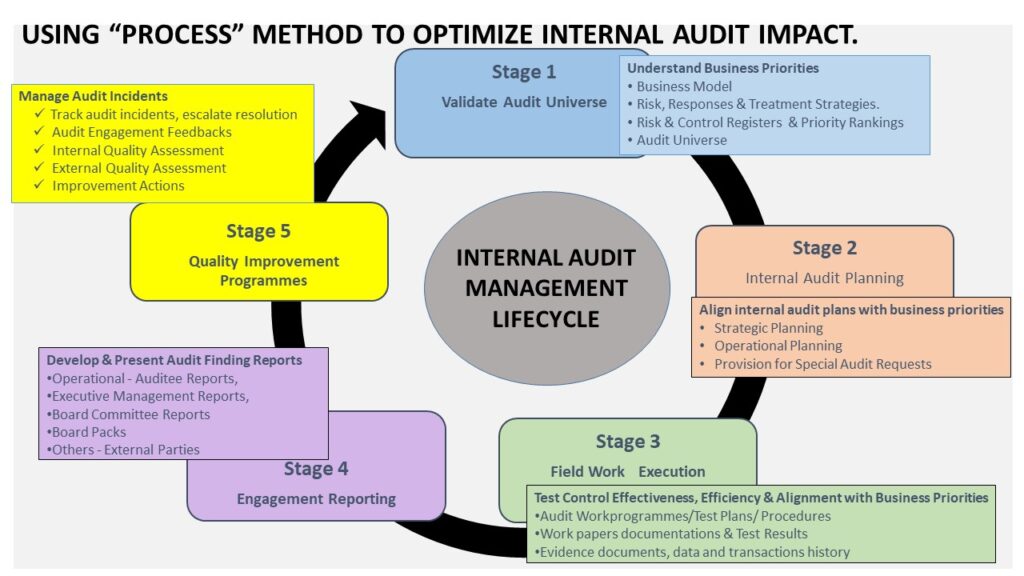Internal Auditing is about
(a) independent Opinion,
(b) Objective advice and
(c) Transformational Impacts.
Internal auditors must be intentional at demonstrating the right attitudes & behaviors at all times across the five stages of the internal audit management life cycle with the pictorial representation displayed below.
Presented below are further high-level summary of the internal audit management life cycle.

(1) stage 1 – Building audit universe by understanding the business model.
(2) Stage 1 – developing strategic & operational internal audit plans and making provisions adhoc audits & investigation based on audit universe, risk focus priorities & justifiable cost benefits.
(3) Stage 3 – Conducting internal audit field work & ensuring robust test plans are used & work papers documentations.
(4) Stage 4 – Preparing audit findings reports for different stakeholders
– operational reports for auditees, Executive Summary reports for Executive Management & Board Committees & Board Pack.
(5) Stage – Performance Feedback, Audit Issues Tracking & Resolution and Process Improvements.
Meeting the above mandates certainly positions internal audit as a truly strategic partner & trusted adviser. This is the expectations of every organization & stakeholders.
Sadly, in most companies, internal audit is perceived by auditees & other stakeholders in the worst negatives including being called cost centers, policing & fault finders.
The root cause for the negative perceptions is mostly due to poor interpersonal, relationship management and communication skills of some internal auditors.
The PROCESS tool is one of the handiest, easiest & important techniques that internal auditors can leverage in the internal audit management lifecycle to address the stakeholders’ expectation gaps, particularly at the auditees level.
How?
PROCESS is an acronym generally used as an ice-breaker to set rules of engagements during training, meeting and focus group sessions.
The description of the letters in the PROCESS word are :
P – participation -effective involvement of everyone.
R – Respect for individual and others.
O – Open mind to give & accept criticisms without bias.
C – Confidentiality – apply lessons learnt without quoting sources.
E – Enthusiasm – show interest in what is happening.
S – Sensitive – avoid being personal, appreciate boundaries.
S – Sense of fun – be humorous with wisdom
Any one or more of the letters missing at any point in during audit engagement delivery breaks the chain of connection & Trust that the internal audit is required to deliver.
How each internal audit team delivers with the PROCESS tool matters.
These requires agreeing the key triggers enabling each of the letters & collective PROCESS word.
The key questions:
What are the key triggers for each of the letters & collective word in your team?
Which letter is missing or needs reinforcement or improvement?
Honest conversations around the meaning & use of PROCESS tool in dealing with auditees could be an eye opener & springboard to achieving greater audit impact.
What do you think?
#Process #audit #risk

